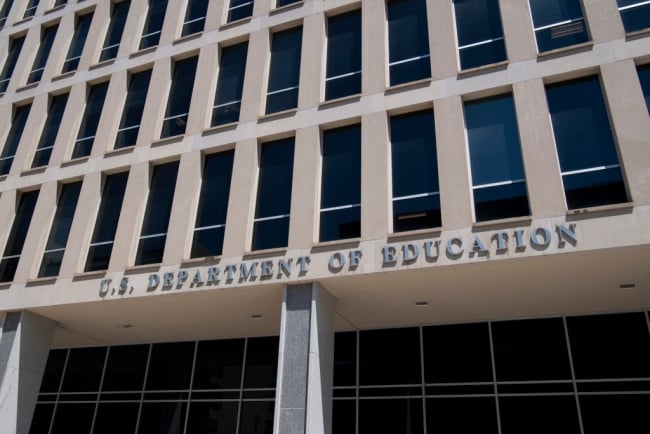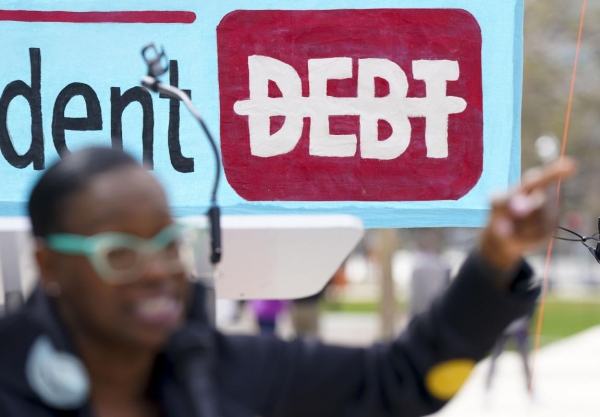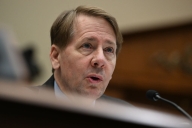You have /5 articles left.
Sign up for a free account or log in.

The Education Department makes policy related to federal student aid using negotiated rule making, which one expert called “the dullest process in higher education policy making.”
Caroline Brehman/CQ-Roll Call Inc./Getty Images
Nearly a year after President Biden first pledged to forgive up to $20,000 in student loans per borrower and less than a month after the Supreme Court struck down that plan, the Education Department is again trying to provide relief.
But this second attempt will take longer—at least 12 months—several experts said, and involves a complicated regulatory process known as negotiated rule making. And any end result could still be subject to a legal challenge.
“I worry about dangling this potential relief in front of borrowers again, so recently after it’s been taken away from them without a really clear path forward,” said Michelle Dimino, deputy director of education at Third Way, a center-left think tank.
At this point, what kind of debt relief the Biden administration will pursue or what plan will even emerge from the negotiations is unclear. What is clear is that the process will be lengthy, technical and fraught with emotion.
Higher education experts say this rule making focused on debt cancellation will be more high profile than previous processes and unlike any other round of rule making. The department already has received more than 12,700 public comments on this issue, dwarfing the 60 it received on its entire regulatory agenda for 2023. That attention will likely help to educate the public about a typically under-the-radar area of the department, but it won’t make the sessions any less technical.
“Welcome to the dullest process in higher education policy making,” Dimino said.
What Is Negotiated Rule Making?
Negotiated rule making, or “neg-reg,” started in the early 1990s. It entails using an advisory committee to consider and discuss issues with the goal of reaching consensus in developing a proposed rule. Consensus means unanimous agreement among the committee members, unless the group agrees on a different definition. The department must do negotiated rule making for any rule related to federal student aid.
This effort also could delay the department’s plans to rewrite or update the regulations for accreditation, cash management and third-party servicers, among other topics. Experts worry that the department won’t have the manpower or bandwidth to follow through on that agenda, which was considered ambitious even before adding debt cancellation to the mix.
Dimino said the administration will need to prioritize the remaining issues. Following through on the agenda would be “a herculean task,” she said.
“When we think about putting resources towards that process, which the Biden administration obviously looks to as part of their legacy and policy priorities, versus the alternative of being able to spend real time working through issues with accreditation and state authorization—things that are more likely to be finalized, go into effect and have an impact on how students are navigating their higher ed system,” Dimino said. “It’s a big trade-off.”
An Education Department spokesperson said the agency had no new information to share on the timeline for its regulatory agenda or how debt relief could affect those plans.
Experts also worry that the rule-making process for debt cancellation could get in the way of finalizing new regulations regarding gainful employment, Title IX of the Education Amendments of 1972 and other topics.
Timing Constraints
The Education Department began down the winding road of rule making Tuesday with a nearly four-hour public hearing. Officials heard from advocates and borrowers who said the student loan system was broken and described the toll ballooning loan balances have taken. The relief promised last August is sorely needed, especially with payments set to resume in October, many borrowers said.
A few borrowers teared up during their public comments. Several speakers also encouraged the department to move quickly to include borrowers in any committee that will discuss policy proposals on debt cancellations.
How to Make a Policy, Neg-Reg Edition
As part of negotiated rule making, the Education Department must:
- Put out a public notice about intent to form a committee and hold a public hearing
- Hold a public hearing
- Publish notice inviting nominations for negotiators
- Pick the negotiators
- Hold negotiated rule-making sessions
- Write the proposed regulations
- Publish those regulations for public comment, which lasts at least 30 days
- Read and respond to the comments; revise the regulations as needed
- Publish the final rule. Rules need to be published by Nov. 1 in order to take effect July 1 of the following year, but the department can implement rules early.
Under Secretary James Kvaal pledged repeatedly in his opening remarks that the administration would move as fast as it can, echoing previous statements from officials who have said it would take months.
“We will help as many borrowers as possible, and we will work as quickly as possible under the law,” he said.
But as quickly as possible means at least a year to 15 months, given the requirements of negotiated rule making, experts said. One of the fastest rule makings in recent years was the 2016 effort to rewrite the borrower defense to repayment rules, one expert said. The department published its notice of intent to establish a committee and hold a public hearing in August 2015. The final rule was published in November 2016.
The Biden administration said after the Supreme Court’s decision that it would push for student loan forgiveness under the Higher Education Act of 1965, which allows the department to “compromise, waive, or release” its claims against borrowers. This is a different law than the one used to justify the previous plan for one-time student loan forgiveness.
Dimino said the department’s approach is a risky one.
“It’s gonna take a long time, but it has risks involved with how we think about the authority in the Higher Education Act,” she said.
Luke Herrine, a law professor at the University of Alabama at Tuscaloosa and an expert on student loans, along with other experts and advocates have made the case over the years that the law allows for mass student loan forgiveness. He said using the Higher Education Act now to cancel student loans is a smarter move but not inherently better.
Following the court’s decision in the student loan case, Herrine is skeptical that the justices would reach a different conclusion if the administration used the Higher Education Act.
Conservative groups and legal experts say the administration’s move is illegal.
“The department must stop legislating new programs in the executive branch, which is not the proper branch for lawmaking,” said Mark Chenoweth, president of the New Civil Liberties Alliance, at the hearing.
Herrine said negotiated rule making for one-time debt relief is “an unnecessary proceeding” and that the department has tools to move faster to provide forgiveness. Other debt-relief advocates agree with Herrine.
Herrine said that the fact the Biden administration is trying to move forward on debt relief at all is a welcome development for advocates. None of the administration’s current efforts, such as reforming income-driven repayment and Public Service Loan Forgiveness, were on the Obama administration’s agenda, he said.
“The political force of student debtors is being felt in a way that it just was not before,” he said.

Aissa Canchola Banez, senior policy adviser and strategist for the Student Borrower Protection Center, said negotiated rule making is an opportunity for borrowers to make their voices heard. The center and other advocacy groups encouraged powers to weigh in at the public hearing or in comments.
“They’re thirsty for information about what they need to do to get this across the finish line,” she said.
Banez said it’s important for the Biden administration to be bold and more generous in its plans for student loan forgiveness.
“We expect the administration’s original proposal to absolutely be the floor,” she said.
Next Steps
Following the public hearing, the department will seek nominations for 12 to 16 negotiators who will serve on the committee and represent different stakeholder groups. Once the negotiators are selected, the actual negotiations will begin. The department likely will release its proposal for debt cancellation at or ahead of the first session.
If the negotiating committee does reach consensus or unanimous agreement on proposed regulations, the department is required to issue those regulations in draft form as part of a Notice for Proposed Rulemaking. If the committee doesn’t agree, the department is free to propose whatever it wants.
Rebecca S. Natow, an assistant professor of educational leadership and policy at Hofstra University who researches federal higher education policy making, said negotiated rule-making sessions “can be very, very boring.”
“There’s sometimes comments about using the word ‘and’ versus ‘or,’ using ‘must’ versus ‘may,’ using a semicolon versus a period,” she said. “There’s likely to be a lot of discussion about the substance of student loan forgiveness, and that part is going to be very interesting, but there’s probably also going to be a lot of talk about minutia that’s not very interesting.”
The department is planning to hold three rule-making sessions over the course of three months, according to a notice in the Federal Register. The shift to online meetings during the pandemic helped to improve the accessibility of negotiated rule making. Natow and others hope those changes stick.
Natow said that department is following a typical timeline for negotiated rule making. She and other experts did note that the department did move quickly over the last month to set up the public hearing, which shows their urgency.
She added department officials probably want to be careful in not moving too quickly on rule making because they could open themselves up to a legal challenge if they don’t do it right.
“I think they’re motivated,” she said. “I think they’ll move as quickly as they can, but that process takes time.”








